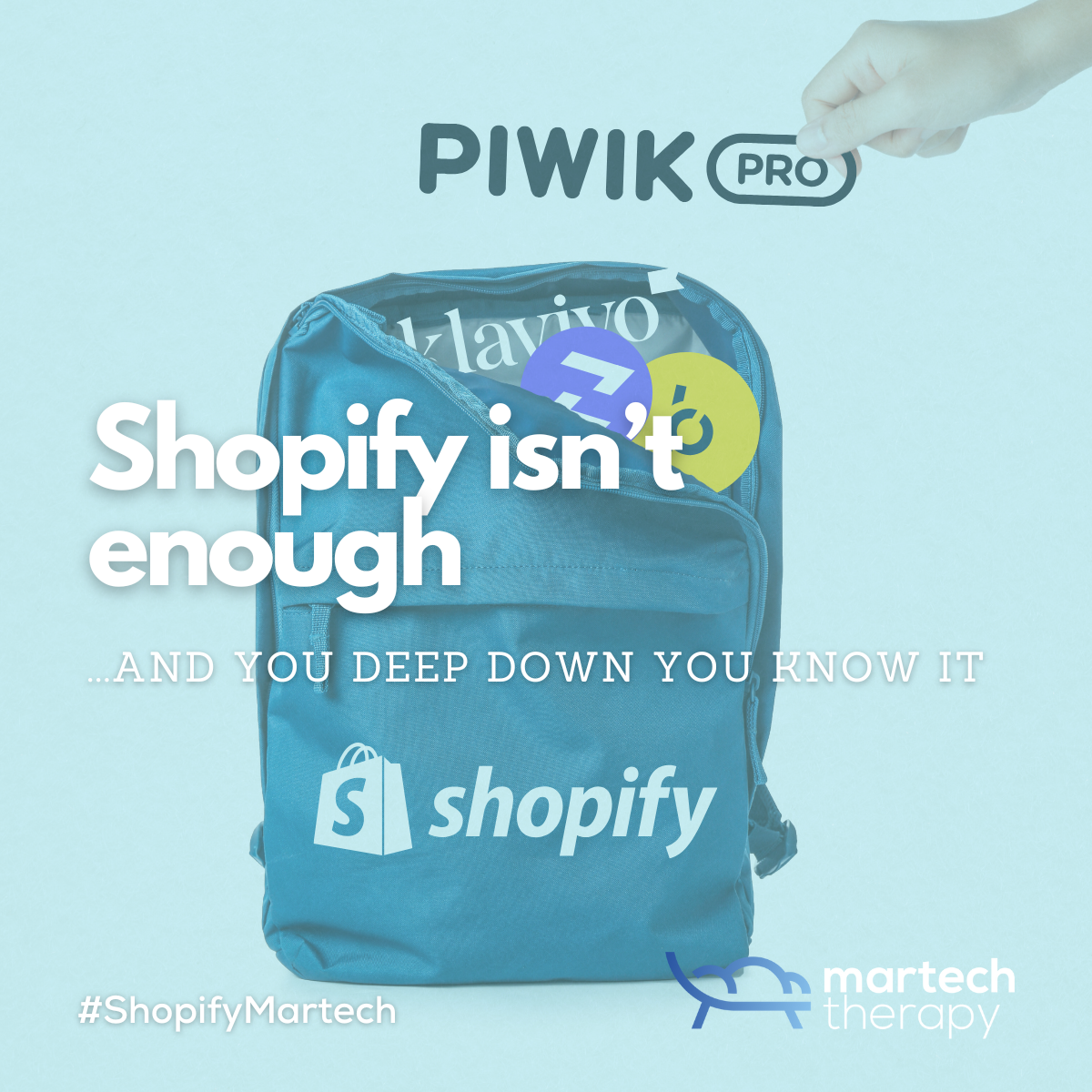There’s a moment that creeps in somewhere between “should I try another email pop-up plugin?” and “why don’t my reports ever answer real questions?” It’s a quiet realization. The platform that made it beautifully easy to launch your store might not be built to help you scale your marketing or understand your customers beyond last Tuesday’s sale.
Shopify does many things well. It’s clean, manageable, and doesn’t ask you to learn code or bribe a developer friend. It’s perfect for what it is: a commerce platform. Not a data platform. Not a campaign engine. And certainly not a customer brain.
Which brings us to the apps.
App store as life raft
If you’ve ever stared into the Shopify App Store looking for “just a bit more insight,” you’re not alone. These apps promise that final nudge from chaos to control. Install Klaviyo, and suddenly you’re sending abandoned cart flows like a seasoned growth hacker. Add Piwik PRO and suddenly you’re a data privacy champion with funnel tracking to match.
But let’s not skip over a few realities.
Yes, these apps can be installed with a click. And yes, many of them, like Klaviyo, Bloomreach, ZEPIC, Piwik PRO, are purpose-built to slot neatly into Shopify’s ecosystem. Klaviyo even got a hundred million dollar thumbs-up from Shopify itself and now wears the title of “strategic email partner for Shopify Plus.” Piwik PRO just launched their own native app with a full analytics suite, a cookieless CDP, and zero-touch setup. You can go from zero to tagged in under an hour.
But that’s just the on-ramp. The actual driving? That’s still on you.
The difference between ‘installed’ and ‘used well’
Here’s the thing you need to keep in mind → one-click install doesn’t mean one-click results.
You can install a CDP, sure. But what data do you actually want to capture? Do you know what a “high-value visitor” looks like on your store? Have you thought about segment decay? Consent expiry? Do you need to? You bet ya!
Even email automation tools like Klaviyo, for all their prebuilt flows and plug-and-play templates, still require judgment. Timing. Copywriting. Common sense. Do you really want to re-engage a customer who bought one candle in 2019 and hasn’t opened a message since?
What I’m saying is, these apps don’t replace strategy. They operationalize it.
Without a clear understanding on what you’re trying to fix or improve, you might just end up with a stack of disconnected tools and dashboards that look impressive but tell you little. Like installing a smart thermostat in a house with no insulation. You’ll know the temperature, just not how to change it.
Where Shopify’s built-ins start to bend
Look, this isn’t a Shopify takedown. Their native tools are fine for what they are. I would even use them if I wanted to start a webshop. You can run basic newsletters through Shopify Email. You can track basic product and order analytics. You can get a general sense of how your store is doing.
But if you start asking more sophisticated questions such as:
- Who are my most profitable customers?
- Which channel brings in high-LTV shoppers?
- What behaviors lead to repeat purchases?
…you quickly outgrow those defaults.
Shopify doesn’t give you cross-channel attribution. It doesn’t offer behavioral segmentation. Its automations are improving, but still live mostly in the shallow end. And if you’re trying to orchestrate campaigns across email, SMS, ads, and maybe even in-store? You’re reaching for more than Shopify offers out of the box.
At that point, tools like Klaviyo, Bloomreach, ZEPIC or Piwik PRO aren’t “nice-to-haves.” They’re gap-fillers. They become necessary because your business has outpaced the basics. That’s a good problem to have. But pretending the basics will keep up forever? That’s how businesses plateau.
When it’s time to go beyond… and how to not mess it up
Adding a martech app should feel like progress, not panic. But I’ve seen merchants rush into five new tools at once, thinking more dashboards equals more insights. What they got instead was duplicated tracking, consent conflicts, and a monthly invoice that looked like a phone book.
If you’re thinking of installing something like Piwik PRO or Bloomreach, start with one clear problem. Maybe it’s attribution. Maybe it’s campaign automation. Maybe it’s understanding your customers beyond just name, email, and last order.
From there, yes → choose the tool. But also plan the setup. Connect it properly. Configure it based on actual business questions. And please: delete the half-working apps you’ve forgotten about. They’re not helping, and they’re definitely slowing your store down.
Lastly, check the permissions. Not all apps play nicely with your data. Reputable vendors will tell you where data lives, how it’s used, and how it can be removed. Others might… not.
You’re not failing. You’re evolving.
Most Shopify merchants aren’t marketers by trade. You’re product people. Founders. Hustlers. That’s why Shopify works so well, because it doesn’t get in your way. But as your customer base grows, the stack that helped you start will start to strain.
The good news is that it is fixable. The better news? You don’t need an enterprise IT team to fix it.
You just need to be clear on what you’re trying to do. Don’t install a CDP because someone said CDP. Install one because you want a better understanding of your customer journey and the native tools aren’t giving it to you.
And if you’re not sure where to start, or what app makes sense, or whether that shiny analytics suite is overkill? That’s what people like me do. Not to sell you software. To keep you from drowning in it.
Connect with me on LinkedIn:
Follow Martech Therapy on:
- Instagram: https://www.instagram.com/martechtherapy/
- Youtube: https://www.youtube.com/@martechtherapy
- Bluesky: https://bsky.app/profile/martechtherapy.bsky.social
Want to read more of my opinions on Martech and how they can help you achieve more? Subscribe for free today 👇🏻



Discussion